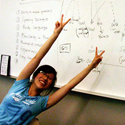Team:British Columbia/Notebook/Week 13
From 2011.igem.org
Watermelon (Talk | contribs) |
Watermelon (Talk | contribs) |
||
| Line 1: | Line 1: | ||
{{Template:Notebook}} | {{Template:Notebook}} | ||
| - | '''Characterization: Limonene synthase''' | + | ''''Characterization: Limonene synthase'''' |
Daisy is beginning expression of the C41 DE3 cells. These cells contain the limonene synthase and other genes from the registry. The C41 DE3 cells also contain another plasmid, from Chris Keeling, called pRARE2. This plasmid codes for rare tRNA codons to help with protein translation. | Daisy is beginning expression of the C41 DE3 cells. These cells contain the limonene synthase and other genes from the registry. The C41 DE3 cells also contain another plasmid, from Chris Keeling, called pRARE2. This plasmid codes for rare tRNA codons to help with protein translation. | ||
Revision as of 18:56, 4 September 2011

 |
 |
 |
 |
 |
'Characterization: Limonene synthase'
Daisy is beginning expression of the C41 DE3 cells. These cells contain the limonene synthase and other genes from the registry. The C41 DE3 cells also contain another plasmid, from Chris Keeling, called pRARE2. This plasmid codes for rare tRNA codons to help with protein translation.
Daisy went to the lab techs to clarify a lot of the steps. Chris Keeling suggested Daisy to follow a protocol in the 2004 Martin paper (http://www.ncbi.nlm.nih.gov/pubmed/15310829). This is because the limonene synthase in the registry is not tagged (not His-tagged specifically) so there is no purification step. Chris Keeling mentioned that they used to do synthase expression without a tag, but it gave messier chromatograms. Now, they use a his-tag for purification purposes. However, the limonene synthase does not have a his-tag so Daisy will be following the previous protocol.
The lab techs (Shannon, Sharon, Harpreet) were extremely nice! In particular, Sharon was very helpful in getting reagents that iGEM did not have, such as geranyl diphosphate (very expensive!!) and pentane (with trace amounts of isobutylbenzene for quantitation) for Daisy (Thanks Sharon!!).
Daisy grew the starter culture of C41 DE3 cells over night. Then she grow the cells in two batches of 500 mL in 2 litre flasks. The cells were then induced with IPTG and grown. Daisy did an overnight expression of the limonene synthase. Daisy then spun down the cells and put them in the -80.
Daisy took 1-2 g of cell pellet with 5 ml of assay buffer. Daisy then sonicated the cells for the in vitro assay. Daisy spun down the cells and took 2 ml of the supernatant for the in vitro assay.
Daisy incubated the 2ml supernatant with geranyl diphosphate (the substrate required for limonene production) and 2 ml of pentane.
There were also several samples that needed to be run on the SDS PAGE. We tried to use the SDS PAGE equipment that we were given. However, the inner chamber kept leaking and we did not know how to prevent the leaking.
The samples were run in Foster Lab, with Jenny Moon's help. There were several samples to run. The goal was to see a difference in expression between wild type yeast and induced yeast expression. However, there was no difference in bands.
 "
"

















